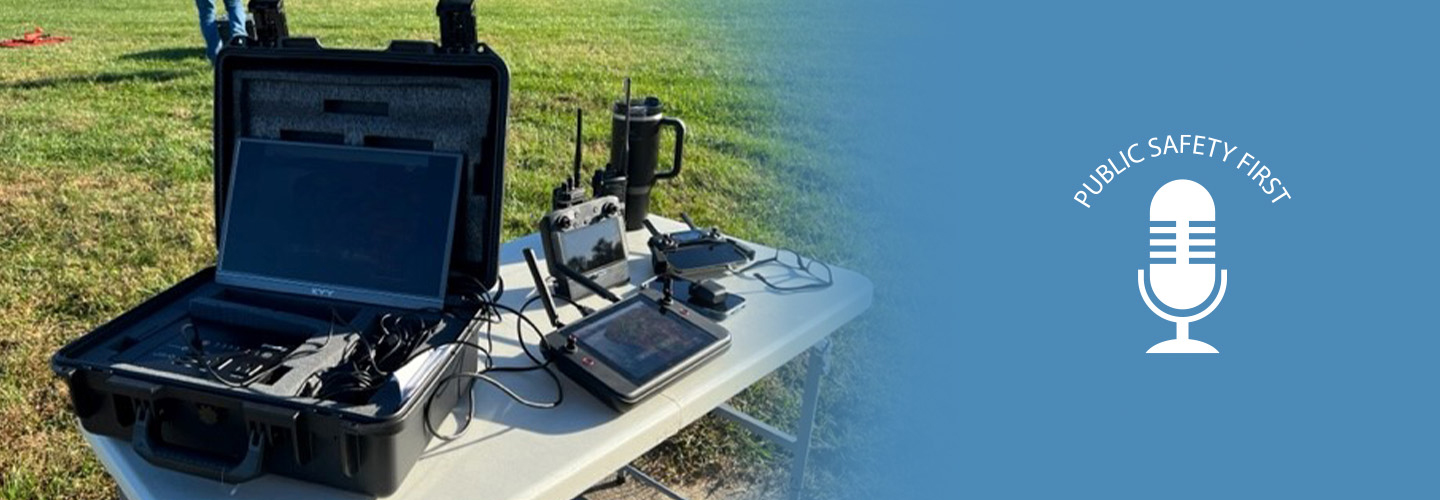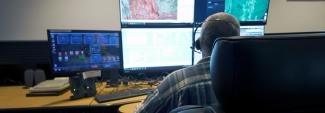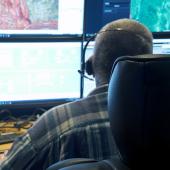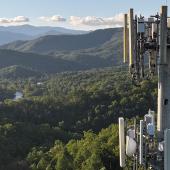Summary
Guest
Lori Stone, FirstNet Authority Senior Public Advisor
Jason Stoddard, Director of School Safety and Security, Charles County Public Schools
Transcript
Preview
Episode 69 | FirstNet goes to school: Keeping Maryland students safe with public safety broadband
Narrator: You're listening to Public Safety First, a podcast to help you learn about the First Responder Network Authority and how you can be part of the future of public safety technology.
And now, your host.
Episode 69 | FirstNet goes to school: Keeping Maryland students safe with public safety broadband
Narrator: You're listening to Public Safety First, a podcast to help you learn about the First Responder Network Authority and how you can be part of the future of public safety technology.
And now, your host.
Lori Stone: Welcome to the Public Safety First podcast. I'm Lori Stone and I'm a senior public safety advisor at the FirstNet Authority. Today, I'll be talking with Jason Stoddard, the director of school safety and security with the Charles County Public School Systems in Maryland. Jason, thank you for being here.
Jason Stoddard: Thank you for having me, Lori. It's an honor to be here.
Lori Stone: Could you start off telling us a little bit about your background and your role with the school system?
Jason Stoddard: I started my public safety career in 1994. I spent a little less than four years in the United States Air Force, where I was a security police officer. When I got out, I spent the next 20 years of my life with the Charles County Sheriff's Office, where I retired as a lieutenant, and came here to the school system about four years ago in 2018 and was the first ever Director of School Safety and Security for the Charles County Public Schools. My history in law enforcement has been fairly unique in that I spent a great deal of my time working critical events, working with incident management teams, learning about emergency management, physical security strategies, things like that. So, I bring a unique blend of experience and education to our organization.
Our School Safety and Security section is set up a little bit different. Not only do we do the physical security and the emergency management side of things, but we also do background investigations, badging and access control. And then we also have a section that does insider threat investigations. We also have an intelligence section. Recently, we started a drone section. So, we do a lot of different things that other school systems just either have in other sections or they don't have it all. So, we try and be as well rounded as we can be to ensure that we are keeping our kids safe and are giving our staff the ability to work in a safe environment.
Lori Stone: That's a lot on your plate there, Jason. I read some of your writings and you often refer to how schools should have a necessary foundation for sustaining positive learning. I like that phrase because it encapsulates what school systems have become. What makes up that foundation, and how does a school safety expert assess what that foundation is?
Jason Stoddard: School safety doesn't start at the doorway of the school or at the threshold of the school property. School safety starts in the community. And school problems are community problems and community problems are school problems. The good thing about schools is, is historically you don't see the crime rates that you do on the outside. And much of that is because of the layered safety and security protocols that many school systems have put in place. When you look at a comprehensive school safety and security plan, it needs to look like an onion.
So, one of the things when we're dealing with emergency management is we use the five D's. Detect, deter, delay, deny, and defend. So, as we're building our strategies, we want to look at each of those and how do our strategies fit into those five D's and that's how we build our onion. So, if we're looking at a deterrence, how do we deter? We're going to talk about having anonymous reporting lines. We're going to look at making sure that we have strong codes of conduct. We're going to look at making sure that we build positive relationships into the way that our teachers and our staff interact with our students, because we're really trying to deter any of those threats in those issues. We're going to look at even social emotional learning and having counseling available because those are all deterrence models. What do we have as far as staff in our hallways and on duty at dismissal and arrival and at bus duties and things like that. So, it all intertwines. It's not just about the physical safety. And then when we look at delaying of an issue, what are our anonymous reporting guidelines? Do we have things like crime solvers tip lines? What kind of mobile apps are we using? What kind of counseling again do we have? What do our locks on our doors look like? What's our physical security look like? How do we deny people from entering into the building or perpetrating whatever nefarious action? And then the defeating portion. What do your standard response protocols look like? How are you communicating? How do you respond with your drills, practicing your drills, things like that?
In the end, it's about building layers that are sustainable and interoperable and that continue to work off of each other because the resiliency factor inside of a school is highly important.
Lori Stone: You have spent several sessions talking with the FirstNet Authority and our partner AT&T about what you want to see on the future for school technologies and developments. I know how busy your schedule is with oversight of 37 schools, 27,000 students, Jason. Why are you making time to talk with the federal government and our partner about school safety and future technology needs?
Jason Stoddard: Well, I think anything that we can do to safeguard our national treasure, which is our kids, is well worth our time. Our job is to concentrate on keeping our students and our staff safe and keeping safe environments so that learning can take place. Those of us that are practitioners in this career field we should be driving the change and driving what needs to be done.
We need to be participating in the R&D. So, taking a few minutes to talk to our federal partners with FirstNet and then AT&T to try and drive some of that change and be that leader in driving that to what we need. And, historically, technology works until you need it the most. We have to get it right every day, every moment of the day. We can't afford to be wrong ever. And in order to help us do that, we have to drive those conversations.
Lori Stone: Well, your background certainly lends a tremendous viewpoint. More than 20 years with the Charles County Sheriffs and before that with the military as a security police officer. How did those roles guide you today where you are? What lessons have you learned?
Jason Stoddard: The more that you practice something, the better off that you can become as long as you're willing to take a holistic approach at it. And I was taught really young in my career that you respond to an event and then you need to sit back and you need to go over what happened and basically perform that after action report on yourself and on the team that you were a part of or that you led. And I think that's been instrumental in the growth of me personally, is being able to sit back and say, wait, you're not always right. You know, one of the other things that I learned very early in my career was the idea that in order to lead people, you have to read and you have to be willing to dive into subjects that challenge your brain and keep you thinking. Nothing that we're experiencing in 2022 is new to the world. It's all happened in the past, and in many cases, the solutions or the things that you want to avoid are documented in other places. You just got to find them. And I think in my career, I've been blessed enough to have some great mentors that have taught me those things.
We always need to be looking six months to a year down the road. And that's a skill that has to be learned and it has to be practiced. And I think anybody who gets into these positions has to understand you are living for today, but planning for tomorrow. You have to be looking out for the greater good.
Lori Stone: When you said living for today and planning for tomorrow, I wrote that down because I think that really resonated with me in my interactions with you, Jason, because you have always been on the forefront of research, of technology, of wanting to try things. Tell me a little bit about how technology has changed how schools operate and students inside schools how they now are.
Jason Stoddard: I think that the first thing that you have to understand about technology and about taking risks because everything is a risk, right? We only have a finite amount of resources and we have to figure out how best to spend those resources. We fail to innovate because of the risk of a failure. However, if you let that deter you, you'll never come up with things like our drone program. You'll never come up with new ideas that will be successful. And I try and tell people all the time, you know, if Thomas Edison had stopped at his 50th time trying to make a light bulb, we never would have had a light bulb. It took him 3,000 times to get it right. So, we have to have the ability to fail when we're trying to innovate. And I think when we look at technology as a whole, the interface between technology and crisis still has not been mastered. Far too often, technology fails when we need it the most. But the only way that we can figure that out is to continue to test it.
For example, at a school shooting that I was at and several other active shooter events and critical public safety events that I've been at, one of the first things that goes down is cell phone towers and the ability to communicate. And in many cases, especially in a K to 12 environment, they go down because the kids all get on their cell phones, the parents all get on their cell phones, and there's a limit to all of that technology. But the only way that we learn what that limit is, and then we expand that limit, is to test it and to try it and to push it to its end. So, we try and test it. We try and push the boundaries for what we can get.
I think we can drive that conversation, but I also think that we have to be realistic. When it comes to technology like what FirstNet and AT&T offer us, we're able to look at things like preemption. And when we're pushing cell phone limits and we're pushing the coverage limits, it's imperative that first responders be able to talk.
Lori Stone: And you have been an early advocate for FirstNet to be used in school safety. Tell me why you believe in this network and how you're using it in Charles County.
Jason Stoddard: So, as I started my career in law enforcement, I started in 1998 at the sheriff's office. Three years later, 9/11 happened. About a year after that, I was deployed to the FBI's Joint Terrorism Task Force. And so, understanding the necessity to be interoperable not only across different stakeholders, but also internally and again, building that redundancy with inside of our system. There was nothing worse than sitting at what was initially dispatched as an active shooter event at a high school, and not being able to communicate. You're in the dark. That's not a good place to be. It's not a good place to get into a command post, get set up with all your gear, turn on your computer, hit the wi-fi, and it doesn't work. So, anything that companies are doing to build in redundancy is something that I'm looking for and that I want to learn about.
So, things like the preemption, that drew me because I've been there and done it. We've experienced it. Coverage, the ability to bring in a COW [cell on wheels], your willingness to come in and do coverage studies and to put into place additional cell phone signal boosters, so that if we do have an event, when I show up with my radio cache, with my routers, I'm now an internal system that I don't have to rely upon the wi-fi of anybody else. It's all right there. So, what FirstNet and AT&T have done for us is, I have a radio cache in the back of my car. I can show up anywhere and set up a router system that has hundreds of laptop capabilities off of it anywhere in our county. So, I'm not now reliant upon the school, the hotel, the church, wherever, we're our own system.
The service has been immaculate. I haven't had any problems or even we've now even moved into the utilization of the FirstNet technology with our drones. And I know no matter where I go with those drones, no matter what's going on, that part's going to work. So, there's a lot of different overlays and redundancies that we've enjoyed that we're very happy with.
Lori Stone: You might be one of the first school systems in Maryland to have a drone program.
Jason Stoddard: We're likely one of the first in the country, if not the first.
Lori Stone: First in the country? Wow. So, Jason, pushing the envelope and the boundaries once again. I love it. What does having drones, then, give you that you didn't have before? I mean, how are you integrating them into your emergency operations plans?
Jason Stoddard: So, the world looks different at 400 feet and the world is much bigger at 400 feet than it is on the ground. Our drones have a couple of different uses. So, we have them not just for emergency response, but we also do a lot with roof inspections, property line inspections, mapping, videotaping. The technology now with aerial platforms I can sit in my office, design a route that I want the drone to fly, take pictures.
From an emergency management standpoint, they're huge with situational awareness. So, when we do have those life threatening or critical events, I don't have to be at the scene. As long as I can see my drone, I can launch my drone from wherever to be able to fly towards that school, at that school or whatever else, and then be able to basically beam those images back to a departmental operations center, so that the decision makers here now have situational awareness to what's going on.
But the other thing that we do with those drones is when we have a situation where the police have an event that has occurred, on a couple of cases, we've actually beaten their drone operators and have offered our technology to their drone operators to say, here you fly our stuff because we got the same drones that they do. Again, another interoperability collaboration event, so that they can fly our platform and then we can give them their footage. And that's where we utilize our drones the most when it comes to the physical security side of things and the emergency management side of things.
Lori Stone: That is really amazing. I hadn’t thought about drones in a school setting before and the visibility it’s giving you not only during routine events like we talked about, but during the emergency events.
So, Jason, with all of this background that you have in law enforcement and you're kind of on the cutting edge of testing and trying things, what would you tell other school safety and security directors? What should they be knowing about FirstNet and what would you encourage them to do?
Jason Stoddard: With the FirstNet technology we're riding on a completely different system. My communications are going to work because it's been tested and that's what it's designed to do. It's supplemented by government oversight, backed by AT&T technologies. Those are the reasons that I think all school systems need to be looking at what is the capability of this. And you know, the other thing that has really impressed me with the FirstNet Authority and AT&T, Charles County, by no means has great cell phone coverage, especially as it relates to AT&T. It hasn't in the past. However, AT&T came down here, did site studies and now we have two brand new towers, and it costs the taxpayers nothing. It cost nothing for the school system or anything else. But they're building that infrastructure. And to me, to have a company that's willing to be that proactive, that's willing to look and to say, hey, we do see our shortages, and acknowledge, yeah, we don't have 100% coverage in Charles County, but we're working on it. To me, that means a lot.
Lori Stone: It’s similar to an AAR that you mentioned earlier about how what happened, let’s now review and go forward in a more positive way.
So, Jason, we've talked about a lot today. Is there anything else that we haven't hit upon that you'd like to discuss?
Jason Stoddard: Just to say that we're all in this together, we are all in the same storm. So, working together in that collaboration piece from vendor to customer, that collaboration is what is what's going to enhance our ability to provide that safe learning environment and sustain it so that our kids can learn and that we do protect them, because they are definitely our national treasure.
Lori Stone: I love ending on the theme of collaboration because that's what we want out of this partnership with AT&T and with public safety. Jason Stoddard, Charles County Schools director of school safety and security, thank you for everything you do to keep our national treasure safe and the hard work that you put in. Thank you for joining us today.
Jason Stoddard: Thank you.
Narrator: Thanks for listening today. We're excited to have you join our podcast community. Make sure to subscribe on iTunes, SoundCloud, and YouTube. You can learn more about the First Responder Network Authority at FirstNet.gov and learn about FirstNet products and services at FirstNet.com.























